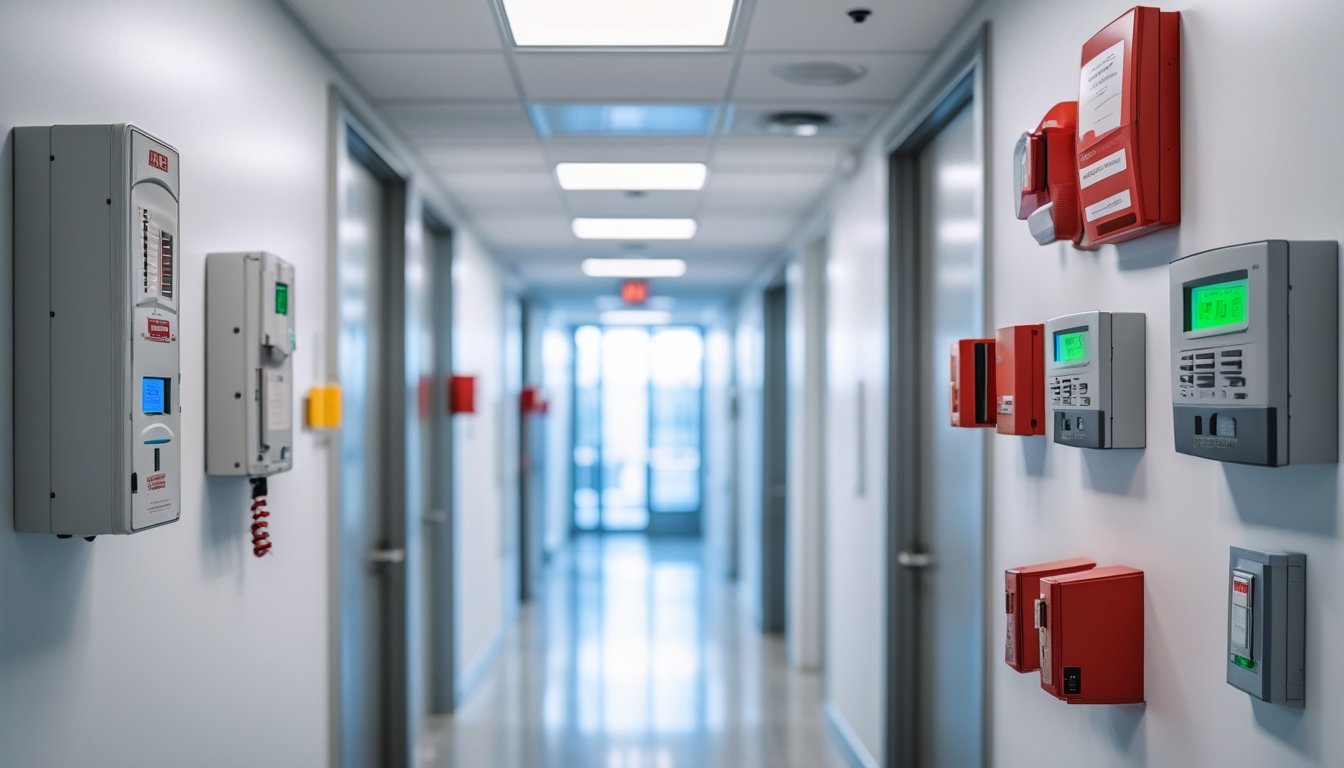When it comes to ensuring the safety of occupants and protecting your assets in large buildings, selecting the right fire alarm system is critical. The best fire alarm systems for large buildings offer advanced features that enhance detection accuracy, streamline monitoring, and integrate seamlessly with your building's safety protocols. With a variety of options available, understanding the key components can help you make an informed choice that meets your specific needs.
In the greater Houston area, compliance with fire safety regulations is essential, and a robust fire alarm system is at the heart of that compliance. Investing in a reliable system can not only minimize damage in case of a fire but also provide peace of mind for you and your occupants. It's vital to consider systems that can adapt to the size and layout of your building while ensuring rapid response times.
As you evaluate the best fire alarm systems available, focus on those that prioritize early detection and offer customizable features. This approach will help you maximize safety and efficiency, ensuring the protection of your large building for years to come.
What Makes a Fire Alarm System Best for Large Buildings
For large buildings, an effective fire alarm system must ensure comprehensive coverage, minimize false alarms, integrate seamlessly with other management systems, and accommodate future growth. Each aspect plays a crucial role in safeguarding both people and property.
Fire Detection Coverage Requirements
Effective fire detection in expansive buildings requires a system designed to cover large areas efficiently. This often includes a combination of smoke detectors, heat detectors, and manual pull stations.
Utilizing addressable fire alarm systems enhances coverage by identifying the specific location of a fire, allowing for focused responses. Per NFPA 72, spacing guidelines for detectors are essential; typically, smoke detectors should not be more than 30 feet apart.
Additionally, consider the unique layout of your building. Complex designs may necessitate specialized detectors or multiple zones to ensure full compliance with fire safety regulations.
False Alarm Prevention in Large Facilities
False alarms can be particularly disruptive in large buildings. Minimizing these requires advanced detection technology and proper system settings.
Photoelectric smoke detectors are less likely to trigger false alarms caused by cooking or steam than their ionization counterparts. Implementing stringent installation and maintenance practices also helps. Regular testing and calibration ensure sensitivity levels are appropriate for different environments.
Moreover, consider using smart technology that can differentiate between actual threats and non-threatening situations. This can result in fewer disruptions while maintaining fire safety.
Integration Capabilities for Building Management
Advanced fire alarm systems should integrate with other building management technologies. This includes security systems, HVAC, and emergency lighting.
Integration allows for a coordinated emergency response, ensuring critical systems react swiftly in case of a fire. For instance, linking fire alarms to your building's HVAC system can help control smoke spread by shutting down air handling units during a fire.
Your fire alarm system should also comply with NFPA 72 for integration capabilities, ensuring seamless operation with existing infrastructure, thereby enhancing overall building safety and management efficiency.
Scalability and Future Expansion
As your business grows, so should your fire alarm system. A scalable system allows for easy upgrades and additions without complete overhauls. This flexibility ensures that as your facility expands, your fire safety measures keep pace.
Consider systems that offer modular components, enabling you to add detectors or control panels as needed. This adaptability can save costs and time versus installing a new system entirely.
Always consult with local fire safety regulations to ensure any upgrades align with your compliance obligations. A forward-thinking approach to fire safety enhances long-term protection for both occupants and property.
Types of Fire Alarm Systems for Large-Scale Applications
When selecting a fire alarm system for large buildings, understanding the different types available is crucial. Each system type offers unique features, benefits, and considerations that can impact safety and effective response times.
Addressable Fire Alarm Systems: Features and Benefits
Addressable fire alarm systems provide precise control and monitoring for large-scale environments. Each detection device is connected to a central panel that identifies its exact location. This capability allows for quick assessment and response during an emergency.
- Key Features:
- Location Identification: Know exactly where the alarm is triggered.
- Scalable Architecture: Easily expand or modify the system as your building requirements change.
- Reduced False Alarms: Advanced technology minimizes nuisance alarms, enabling more accurate responses.
These systems are ideal for complex structures, providing real-time data that enhances safety and response strategies.
Conventional Fire Alarm Systems: Advantages and Limitations
Conventional fire alarm systems utilize zones to detect fires across large facilities. All devices in a zone share the same circuit, signaling an alarm when activated.
- Advantages:
- Lower Initial Cost: Generally more affordable than addressable systems.
- Simplicity: Easier to install in small to medium-sized buildings.
- Limitations:
- Vague Alarm Location: You won’t know which device triggered the alarm without further investigation.
- Limited Flexibility: Expanding the system requires more extensive modifications.
While conventional systems can serve well in smaller applications, they may fall short in larger buildings where precise location tracking is essential.
Emerging Wireless and Hybrid Configurations
Wireless and hybrid fire alarm systems are gaining traction in large buildings due to their flexibility and ease of installation. Hybrid models integrate both wired and wireless components, catering to diverse building structures.
- Benefits:
- Installation Flexibility: No need for extensive wiring, reducing costs and downtime.
- Enhanced Detection Capabilities: These systems can incorporate advanced detection devices like multi-sensor alarms for improved safety.
Wireless options are particularly useful in retrofitting existing buildings where traditional wiring is challenging or impossible. They offer a modern approach to fire safety that adapts to your facility's specific needs.
Key Features of Modern Fire Alarm Systems
Modern fire alarm systems are equipped with innovative features designed to enhance safety and response capabilities in large buildings. These systems integrate advanced technologies, allowing for more effective detection and monitoring capabilities while ensuring ease of use for occupants and safety personnel.
Multi-Criteria Detectors and Sensors
Multi-criteria detectors combine multiple sensing technologies to improve detection accuracy. These devices often incorporate heat detectors, smoke sensors, and even carbon monoxide detectors.
By integrating various detection methods, they reduce the likelihood of false alarms. For example, when the heat and smoke readings are simultaneously triggered, the alarm system can make a more informed decision.
Using multi-criteria sensors increases the reliability of fire detection in complex environments, such as warehouses or high-rise buildings, where varying conditions may affect sensors.
Remote Monitoring and Predictive Maintenance
Remote monitoring capabilities enhance the efficiency of fire alarm systems. You can oversee the status of your system in real-time, receiving alerts if a fault occurs or maintenance is required.
This feature ensures that you can respond promptly to issues before they escalate. Predictive maintenance can also be integrated, using analytics to forecast when components might fail, reducing downtime.
By maintaining your system proactively, you decrease the risk of malfunctions during emergencies, ensuring that your safety measures are always operational.
Manual Pull Stations and User Interfaces
Manual pull stations are essential for allowing building occupants to alert others to a fire quickly. These stations should be strategically placed throughout the building for maximum accessibility.
A user-friendly interface on pull stations makes it simple for anyone to activate the alarm in case of a fire. Clear labeling and intuitive designs minimize confusion during emergencies, ensuring a swift response.
The combination of effective design and strategic placement aids in faster evacuation and communication with emergency services.
Advanced Control Panels and Notification Devices
Control panels serve as the brain of any fire alarm system. They process signals from detection devices and issue alerts for the appropriate response.
Modern panels are designed to be user-friendly, featuring screens that display real-time data on system status and any issues detected.
Notification devices, such as strobes and audible alarms, are crucial for ensuring that everyone in the building is alerted to potential danger. These devices can be programmed for different scenarios to tailor the alerts to specific needs, enhancing safety in various environments.
By investing in high-quality control panels and notification systems, you increase the effectiveness of your fire safety protocols.
Ensuring Compliance and Optimal Performance
Ensuring compliance with fire safety regulations is essential for the optimal performance of fire alarm systems in large buildings. Maintaining adherence to standards protects occupants and mitigates liability risks for property owners.
Fire Safety Regulations and Codes
Fire alarm systems must comply with various regulations, including those outlined in NFPA 72, which specifies the national standards for fire alarm system installation and performance. You should familiarize yourself with local fire safety codes, as they can vary significantly.
Key aspects to consider include:
- Detection and Notification: Systems must provide timely alerts to occupants.
- Maintenance Requirements: Compliance often necessitates routine inspections.
- Documentation: Keep records of inspections and system changes for reference.
Adhering to these regulations helps ensure safety and enables your building to pass inspections.
Professional Installation and Regular Maintenance
Proper installation by certified professionals is crucial for your fire alarm system's effectiveness. Only trained technicians should handle setup to ensure compliance with applicable codes and standards.
Regular maintenance is equally important. Schedule:
- Annual Inspections: Professional reviews validate system functionality.
- Monthly Tests: Conduct tests of alarms and notifications to confirm they work correctly.
- Immediate Repairs: Address any identified issues promptly to avoid safety violations.
This diligence ensures your system operates efficiently and adheres to regulations.
System Testing and Documentation
Routine testing of your fire alarm system is vital for optimal performance. You should perform these tests at least once a month, focusing on:
- Alarm Functionality: Ensure alarms activate appropriately.
- Emergency Notifications: Verify that communication systems alert occupants effectively.
- Battery Checks: Assess power sources to prevent failures during emergencies.
Additionally, maintaining accurate documentation of inspections and tests supports compliance and provides a record for authorities. You can utilize a logbook or digital platforms to track this information consistently.
By prioritizing compliance and performance in your fire alarm system approach, your building will be better equipped to protect lives and property.
Frequently Asked Questions
Selecting an effective fire alarm system for a large building involves understanding its features, compliance regulations, and best practices. Here are detailed answers to common questions that arise in this context.
What are the key features to look for when selecting a fire alarm system for a large building?
You should consider systems that offer addressable capabilities. Addressable systems can pinpoint the exact location of a fire, allowing for quicker response times.
Reliable communication features are also crucial. Look for systems that incorporate both audible alarms and visual alerts to ensure all occupants are informed.
Finally, scalability is important. Choose a system that can be expanded as your building’s needs change.
How do the top fire alarm manufacturers compare in terms of reliability and cost?
When evaluating manufacturers, consider both reputation and performance. Brands with a long history of operations often have proven reliability.
Cost varies significantly between top manufacturers. Evaluate the initial investment against ongoing maintenance costs to find the best long-term value.
Key players in the market should offer detailed specifications that support their reliability claims.
What are the best practices for installing a fire alarm system in a large commercial building?
Proper installation ensures the effectiveness of your fire alarm system. Engage certified professionals who are familiar with local codes in the greater Houston area.
Additionally, conduct a thorough risk assessment before installation. Tailoring the system to your building’s layout and occupancy enhances safety.
Routine checks and maintenance are vital post-installation. Schedule regular inspections for optimal performance.
How does the integration of newer technologies improve fire alarm systems in large buildings?
Modern systems often incorporate smart technology, allowing for real-time monitoring and alerts. These features enable quicker responses to potential hazards.
Furthermore, advancements in sensor technology enhance detection accuracy, reducing false alarms and improving trust in the system's alerts.
Cloud-based systems provide convenient access to management data from any location, simplifying monitoring tasks.
What factors should be considered when deciding the number of fire alarms needed for a large building?
You should assess the building’s size and occupancy type. Larger spaces or those with higher occupancy levels necessitate more devices.
Local fire codes play a crucial role in determining requirements. Be sure to comply with guidelines specific to the greater Houston area.
Finally, consider the layout of the building. Strategic placement of alarms ensures complete coverage.
How to ensure compliance with fire safety regulations when choosing a fire alarm system for a large building?
Familiarize yourself with the relevant local regulations, including those set by the NFPA. Compliance with these standards is essential for ensuring safety.
Working with experienced professionals familiar with Houston regulations can streamline the process. They can guide you through necessary compliance steps and paperwork.
Regularly review your system and upgrade as needed to maintain compliance with evolving laws and standards.
.svg)



.svg)


.svg)



